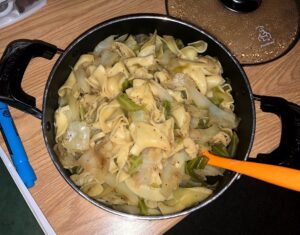Haluski (Fried Cabbage and Noodles)
| Submitted by: Nissa Medwid, Graduate Student, Genetics, Genomics and Bioinformatics |
|---|
Haluski is a hot, flavorful, and comforting meal during the wintertime that can be enjoyed as a main or side dish. It is simple to prepare and hearkens back to times when Slavic people experienced times of hunger and scarcity, reminding me that the human spirit is both creative and destructive and that food is a vehicle of love with which we comfort each other.
| Servings: 5-7 | Cultural Connection: Eastern European (Lemko) |
|---|

Ingredients
| ½ stick of butter cut into several thick slices, using up to a full stick if needed | 1 head of cabbage, cored and sliced into ¼ inch pieces | 1 onion of your choice (not red), diced |
|---|---|---|
| 2 cups of wide egg noodles, cooked al dente (firm) in salted water | Salt and pepper, to taste |
Instructions
- In a large pot or saucepan, preferably with a lid, begin sautéing all the diced onions on medium to high heat.
- In another pot, boil the 2 cups of noodles in salted water to your preference, but firm noodles are better because they won’t rip apart during combining the noodles and cabbage. Strain and set aside.
- Once the onions are translucent, begin adding handfuls of sliced cabbage to the onions and more butter slices. Season with salt and pepper as you add cabbage to ensure that the ratio will season all the cabbage. Once all the cabbage is added, cover it with a lid. The pot will be quite full of raw cabbage.
- After about 5 minutes, the cabbage should start to cook down and steam will accumulate on the lid. Uncover and stir every 3-5 minutes to ensure all the cabbage is cooked and that the food at the bottom won’t burn.
- After about 15 minutes, the cabbage should be translucent and pleasant to chew and its volume will have gone down dramatically in the pot as it loses water. Browning of the onions or cabbage during cooking will add more flavor to the dish. Lastly, fold in all the noodles and season everything to taste.
- This dish is commonly adapted to include meat, particularly bacon or pork. If you would like to add a meaty, smoky flavor to this dish, add bacon/pork just before adding the onions.
